
An intercontinental ballistic missile (ICBM) is a ballistic missile with a range greater than 5,500 kilometres (3,400 mi), primarily designed for nuclear weapons delivery. Conventional, chemical, and biological weapons can also be delivered with varying effectiveness, but have never been deployed on ICBMs. Most modern designs support multiple independently targetable reentry vehicle (MIRVs), allowing a single missile to carry several warheads, each of which can strike a different target. The United States, Russia, China, France, India, the United Kingdom, Israel, and North Korea are the only countries known to have operational ICBMs.
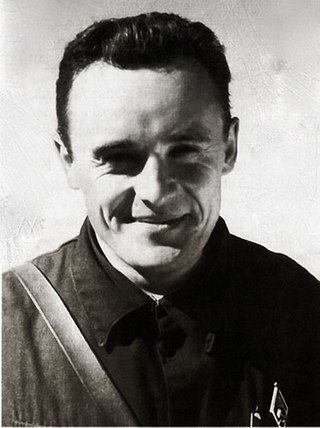
Sergei Pavlovich Korolev was the lead Soviet rocket engineer and spacecraft designer during the Space Race between the United States and the Soviet Union in the 1950s and 1960s. He invented the R-7 Rocket, Sputnik 1, and was involved in the launching of Laika, Sputnik 3, the first human-made object to make contact with another celestial body, Belka and Strelka, the first human being, Yuri Gagarin, into space, Voskhod 1, and the first person, Alexei Leonov, to conduct a spacewalk.

The R-7 Semyorka, officially the GRAU index 8K71, was a Soviet missile developed during the Cold War, and the world's first intercontinental ballistic missile. The R-7 made 28 launches between 1957 and 1961. A derivative, the R-7A, was operational from 1960 to 1968. To the West it was unknown until its launch. In modified form, it launched Sputnik 1, the first artificial satellite, into orbit, and became the basis for the R-7 family which includes Sputnik, Luna, Molniya, Vostok, and Voskhod space launchers, as well as later Soyuz variants. Various modifications are still in use and it has become the world’s most reliable space launcher.
The R-16 was the first successful intercontinental ballistic missile deployed by the Soviet Union. In the West it was known by the NATO reporting name SS-7 Saddler, and within Russia, it carried the GRAU index 8K64.

The R-2 was a Soviet short-range ballistic missile developed from and having twice the range as the R-1 missile. Developed from 1946-1951, the R-2 entered service in numbers in 1953 and was deployed in mobile units throughout the Soviet Union until 1962. A sounding rocket derivative, the R-2A, tested a prototype of the dog-carrying capsule flown on Sputnik 2 in 1957. The same year, the R-2 was licensed for production in The People's Republic of China, where it entered service as the Dongfeng 1.
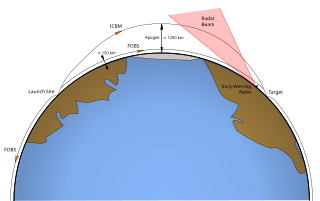
A Fractional Orbital Bombardment System (FOBS) is a warhead delivery system that uses a low Earth orbit towards its target destination. Just before reaching the target, it deorbits through a retrograde engine burn.

The R-9 was a two-stage IRBM of the Soviet Union, in service from 1964 to 1976.

The R-5 Pobeda was a medium range ballistic missile developed by the Soviet Union during the Cold War. The upgraded R-5M version, the first Soviet missile capable of carrying a nuclear weapon, was assigned the NATO reporting name SS-3 Shyster and carried the GRAU index 8K51.

The R-12 Dvina was a theatre ballistic missile developed and deployed by the Soviet Union during the Cold War. Its GRAU designation was 8K63, and it was given the NATO reporting name of SS-4 Sandal. The R-12 rocket provided the Soviet Union with the capability to attack targets at medium ranges with a megaton-class thermonuclear warhead and constituted the bulk of the Soviet offensive missile threat to Western Europe. Deployments of the R-12 missile in Cuba caused the Cuban Missile Crisis in 1962. A total of 2335 missiles were produced; all were destroyed in 1993 under the START II treaty.
The Global Rocket 1 was a Fractional Orbital Bombardment System (FOBS) intercontinental ballistic missile (ICBM) developed but not deployed by the Soviet Union during the Cold War. The system also was given the NATO reporting name SS-X-10 Scrag, and carried a Soviet GRAU index of 8K713 (8К713).

The RT-2 was an intercontinental ballistic missile deployed by the Soviet Union, which was in service from December 1968 until 1976. It was assigned the NATO reporting name SS-13 Savage and carried the GRAU index 8K98. Designed by OKB-1, about 60 were built by 1972.
The UR-200 was an intercontinental ballistic missile (ICBM) developed by Vladimir Chelomey's OKB-52 in the Soviet Union. It was known during the Cold War by the NATO reporting name SS-10 Scrag and internally by the GRAU index 8K81. The design was authorized by the Decisions of the Central Committee of the CPSU of March 16 and August 1, 1961, and the draft project was finished in July 1962. It first flew on November 4, 1963, from the Baikonur Cosmodrome. The ninth and final flight was conducted on October 20, 1964.

The Main Missile and Artillery Directorate of the Ministry of Defense of the Russian Federation, commonly referred to by its transliterated Russian acronym GRAU (ГРАУ), is a department of the Russian Ministry of Defense. It is subordinate to the Chief of Armament and Munition of the Russian Armed Forces, a vice-minister of defense.
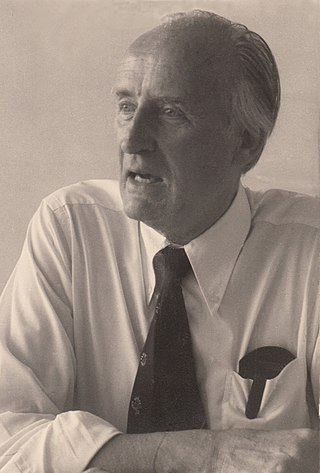
Helmut Gröttrup was a German engineer, rocket scientist and inventor of the smart card. During World War II, he worked in the German V-2 rocket program under Wernher von Braun. From 1946 to 1950 he headed a group of 170 German scientists who were forced to work for the Soviet rocketry program under Sergei Korolev. After returning to West Germany in December 1953, he developed data processing systems, contributed to early commercial applications of computer science and coined the German term "Informatik". In 1967 Gröttrup invented the smart card as a "forgery-proof key" for secure identification and access control or storage of a secure key, also including inductive coupling for near-field communication (NFC). From 1970 he headed a start-up division of Giesecke+Devrient for the development of banknote processing systems and machine-readable security features.

The R-7 family of rockets is a series of rockets, derived from the Soviet R-7 Semyorka, the world's first intercontinental ballistic missile (ICBM). More R-7 rockets have been launched than any other family of large rockets.

The R-11 Zemlya, GRAU index 8A61 was a Soviet tactical ballistic missile. It is also known by its NATO reporting name SS-1b Scud-A. It was the first of several similar Soviet missiles to be given the reporting name Scud. Variant R-11M was accepted into service, with GRAU index 9K51 (9К51).
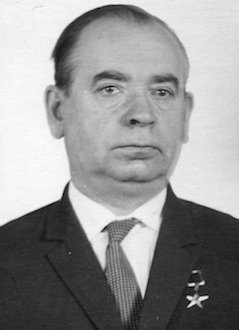
Leonid Alexandrovich Voskresensky was a Soviet engineer in the Soviet space program, and long-time associate of Chief Designer Sergei Korolev. He served as launch director for Sputnik and for the first crewed space flight, Vostok 1. The lunar crater Voskresenskiy is named in his honor.
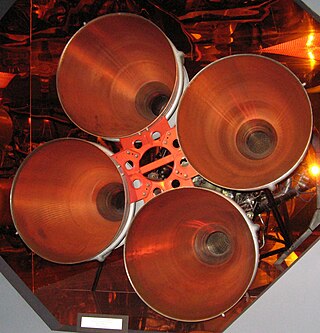
Soviet rocketry commenced in 1921 with development of Solid-fuel rockets, which resulted in the development of the Katyusha rocket launcher. Rocket scientists and engineers, particularly Valentin Glushko and Sergei Korolev, contributed to the development of Liquid-fuel rockets, which were first used for fighter aircraft. Developments continued in the late 1940s and 1950s with a variety of ballistic missiles and ICBMs, and later for space exploration which resulted in the launch of Sputnik 1 in 1957, the first artificial Earth satellite ever launched.

Reactive Scientific Research Institute was one of the first Soviet research and development institutions to focus on rocket technology. RNII developed the Katyusha rocket launcher and its research and development were very important for later achievements of the Soviet rocket and space programs.
During World War II, Nazi Germany developed rocket technology that was more advanced than that of the Allies and a race commenced between the Soviet Union and the United States to capture and exploit the technology. Soviet rocket specialists were sent to Germany in 1945 to obtain V-2 rockets and worked with German specialists in Germany and later in the Soviet Union to understand and replicate the rocket technology. The involvement of German scientists and engineers was an essential catalyst to early Soviet efforts. In 1945 and 1946 the use of German expertise was invaluable in reducing the time needed to master the intricacies of the V-2 rocket, establishing production of the R-1 rocket and enabling a base for further developments. However, after 1947 the Soviets made very little use of German specialists and their influence on future Soviet rocketry was marginal.


















